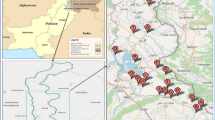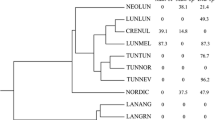Abstract
In order to determine the pattern of genetic diversity within and among the species of Cicer and to estimate interspecific genetic relationships, allelic variation was assayed for 23 isozyme loci in 63 accessions of 11 species of Cicer using starch gel electrophoresis. The total allozymic variation observed in the genus (H t )was equal to 0.60. When partitioned (G st), 96% of this allelic diversity was found among rather than within species. The allelic diversity among species (D st)and allelic diversity within species (H s)were equal to 0.58 and 0.02, respectively. Cicer reticulatum and C. pinnatifidum had the highest proportion of polymorphic loci (17.39%) and the highest mean number of alleles per locus (1.22 and 1.17, respectively). UPGMA cluster analysis of Nei's unbiased genetic distance revealed four genetic groups. One includes C. reticulatum, C. arietinum and C. echino spermum where the first 2 species represent a putative derivative-progenitor pair. A second cluster contains C. bijugum, C. pinnatifidum and C. judaicum. Cicer yamashitae, C. chorassanicum, C. anatolicum and C. songoricum form a third group. Finally, C. cuneatum, which has a very distinct isozyme profile and peculiar morphological features, is the only member of a fourth species group. This species grouping agrees partially with those obtained from crossability and cytogenetic studies. The results suggest that the annual habit arose from perennial progenitors at least twice in the genus Cicer.
Similar content being viewed by others
References
Ahmad F, Gaur PM, Slinkard AE (1992) Isozyme polymorphism and phylogenetic interpretations in the genus Cicer L. Theor Appl Genet 83:620–627
Crawford DJ (1983) Phylogenetic and systematic inferences from electrophoretic studies. In: Tanksley SD, Orton TJ (eds) Isozymes in plant genetics and breeding, part A. Elsevier Science, Amsterdam, pp 257–287
Crawford DJ (1989) Enzyme electrophoresis and plant systematics. In: Soltis DE, Soltis PS (eds) Isozymes in plant biology. Dioscorides Press, New York, 146–164
Crawford DJ (1990) Plant molecular systematics: macromolecular approaches. Wiley-Interscience Publ, New York
Ellstrand NC (1984) Multiple paternity within the fruits of the wild radish, Raphanus sativus. Am Nat 123:819–828
Eshel Y (1968) Flower development and pollen viability of chickpea (Cicer arietinum L.). Isr J Agric Res 18:31–33
Garvin DF, Roose ML, Waines JG (1989) Isozyme genetics and linkage in tepary bean, Phaseolus acutifolius A. Gray. J Hered 80:373–376
Gaur PM, Slinkard AE (1990a) Genetic control and linkage relations of additional isozyme markers in chickpea. Theor Appl Genet 80:648–656
Gaur PM, Slinkard AE (1990b) Inheritance and linkage of isozyme coding genes in chickpea. J Hered 81:455–461
Gottlieb LD (1973) Enzyme differentiation and phylogeny in Clarkia franciscana, C. rubicunda and C. amoena. £volution 27: 205–214
Gottlieb LD (1977) Electrophoretic evidence and plant systematics. Ann Mo Bot Gard 64:161–180
Gottlieb LD (1981) Electrophoretic evidence and plant populations. Prog Phytochem 7:1–46
Gowda CLL (1981) Natural outcrossing in chickpea. Int Chickpea Newsl 5:6
Hamrick JL, Godt MJW (1990) Allozyme diversity in plant species. In: Brown AHD, Clegg MT, Kahler AL, Weir BS (eds) Plant population genetics, breeding and genetic resources. Sinauer Assoc Publ, Sunderland, Mass., pp 43–63
Jaiswal HK, Singh BD, Singh RM (1984) Possible origin of desi chickpeas through introgression of C. reticulatum genes. Int Chickpea Newsl 11:18–20
Kabir G, Singh RM (1988) Seed protein electrophoresis in six species and two F1s of Cicer. Proc Indian Acad Sci (Plant Sci) 98:183–189
Kazan K, Muehlbauer FY (1991) Allozyme variation and phylogeny in annual species of Cicer (Leguminosae). Plant Syst Evol 175:11–21
Kazan K, Kusmenoglu I, Muehlbauer FY, Weeden NF (1991) Duplication of aldolase and esterase loci in Cicer (Cicereae Alef.). J Hered 82:58–63
Ladizinsky G (1975) A new Cicer from Turkey. Notes R Bot Gard Edinburgh 34:201–202
Ladizinsky G, Adler A (1975) The origin of chickpea as indicated by seed protein electrophoresis. Isr J Bot 24:183–189
Ladizinsky G, Adler A (1976) Genetic relationships among the annual species of Cicer L. Theor Appl Genet 48:197–203
Lewis H (1962) Catastrophic selection as a factor in speciation. Evolution 16:257–271
Lewis H (1973) The origin of diploid neospecies in Clarkia. Am Nat 107:161–170
Mercy ST, Kakar SK (1975) Barrier to interspecific crosses in Cicer. Proc Indian Natl Sci Acad B 41:78–82
Muehlbauer FY, Singh KB (1987) Genetics of chickpea. In: Saxena MJ, Singh KB (eds) The chickpea. CAB Intl Publ, UK, pp 99–125
Nei M (1978) Estimation of average heterozygosity and genetic distance from a small number of individuals. Genetics 89:583–590
Niknejad M, Khosh-Khui M (1972) Natural cross pollination in gram (C. arietinum L.). Indian J Agric Sci 42:273–274
O'Malley D, Wheeler NC, Gines RP (1980) A manual for starch gel electrophoresis. University of Wisconsin, Dept For Staff Paper Ser No. 11
Oram RN, Shaikh MAQ, Zaman KMS, Brown AHD (1987) Isozyme similarity and genetic differences in morphology between Hyprosola, a high yielding, high protein mutant of chickpea (Cicer arietinum L.) and its parental cultivar. Environ Exp Bot 27:455–462
Pundir RPS, van der Maesen LJG (1983) Interspecific hybridization in Cicer. Int Chickpea Newsl 8:4–5
Saxena MC (1990) Problems and potential of chickpea production in the nineties. In: Van Rheenen HA, Saxena MC (eds) Chickpea in the nineties. Proc 2nd Intl Workshop Chickpea Improvement. International Crops. Research Institute for the Semi-Arid Tropics (ICRISAT). Patancheru, Andhra Pradesh, India, pp 13–25
Singh RB, Jaiswal HK, Singh RM, Singh AR (1984) Isolation of early flowering recombinants from the interspecific cross between C. arietinum and C. reticulatum. Int Chickpea Newsl 11: 14–16
Smirnoff P, Rotman M, Ladizinsky G (1981) Presence and activity of trypsin and chymotrypsin isoinhibitors in the annual species of Cicer. Biochem Syst Ecol 9:23–25
Soltis DE, Haufler CH, Darrow DC, Gastony GJ (1983) Starch gel electrophoresis of fern: a compilation of grinding buffers, gel and electrode buffers, and staining schedules. Am Fern J 73:9–27
Swofford DL, Selander RK (1981) BIOSYS. I. A FORTRAN program for the comprehensive analysis of electrophoretic data in population genetics and systematics. J Hered 72:281–283
Tuwafe S, Kahler AL, Boe A, Ferguson M (1988) Inheritance and geographical distribution of allozyme polymorphisms in chickpea (C. arietinum). J Hered 79:170–174
Vairinhos F, Murray DR (1983) The seed proteins of chickpea: comparative studies of Cicer arietinum, C. reticulatum and C. chinospermum (Leguminosae) plant Syst Evol 142:11–22
van der Maesen LJG (1972) Cicer L., a monograph of the genus, with special reference to the chickpea (Cicer arietinum L.), its ecology and cultivation. Meded Landbouwhogesch Wageningen 72–10, 342 pp
van der Maesen LJG (1987) Origin, history and taxonomy of chickpea. In: Saxena MC, Singh RB (eds) The chickpea. CAB Int Publ, UK, pp 11–34
Weeden NF (1983) Plastid isozymes. In: Tanksley SD, Orton TJ (eds) Isozymes in plant genetics and breeding, part A. Elsevier Sci, Amsterdam, pp 139–156
Author information
Authors and Affiliations
Additional information
Communicated by A. L. Kahler
Rights and permissions
About this article
Cite this article
Tayyar, R.I., Waines, J.G. Genetic relationships among annual species of Cicer(Fabaceae) using isozyme variation. Theoret. Appl. Genetics 92, 245–254 (1996). https://doi.org/10.1007/BF00223381
Received:
Accepted:
Issue Date:
DOI: https://doi.org/10.1007/BF00223381




